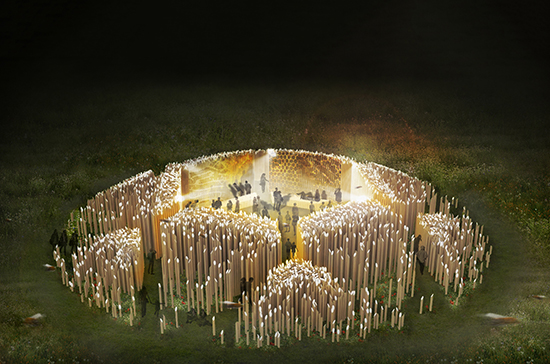Nottingham artist Wolfgang Buttress’s fascination with bees began the first time he picked up a structural part of a beekeeper’s hive – a hive frame.
“It was the sound that really got me,” he said. “It was a low, deep, visceral hum, and instead of making me feel anxious, it did the reverse. I felt incredibly calm.”
Now, Buttress wants to bring that sound to visitors of this year’s Glastonbury festival, via the debut of BEAM, his newest sculpture. A collaboration with Greenpeace, it’s a multi-sensory experience focused on creating a “symphony of bee and man.” During the festival, which runs from June 26-30, BEAM will use vibration sensors called accelerometers placed in black bee colonies on Michael Eavis’ Worthy Farm to express the vibration of the bees through lighting and sound. This is the same technique used in Buttress’s previous work, the Hive at Kew Gardens, and was developed using the research of Dr. Martin Bencsik of Nottingham Trent University.
The structure of BEAM is about 30 meters in diameter and made of locally-sourced timber. Walking into the hexagonal centre, visitors will be blocked off from the sights and sounds of the festival by walls around four metres tall.
“All you can see is the sky and the trees,” Buttress told us. “There will be a relationship between you, the sky, the trees and the sound of the bees.”
Music is also a huge part of BEAM. It will incorporate the hum of the bees with the rhythm of an MRI scanner used to capture the images of the honeycomb projected on the sculpture. Accompanied by harmonious stems created by the band BE, who previously worked on the Hive, alongside members of Spiritualized and Sigur Rós, as well as artists like Daniel Avery, Kelly Lee Owens, Camille Christel and Matt Black, the soundscape will change from calm in the morning to energetic and pulsating as the bees go about their daily routines. In addition, a recording studio will be set up in an on-site shipping container for musicians performing at Glastonbury to add their own sounds to the symphony.
For Buttress, music was an obvious addition to BEAM, helping visitors understand bees. “Music is vibration, and vibration is how bees communicate. It’s the perfect way to express how bees express themselves,” he said.
However, the backdrop of Glastonbury created a new sound landscape BEAM had to navigate. Instead of trying to drown out the music and bustle of the festival, Buttress wants to incorporate them into the piece. BEAM is equipped with sensors which will tune the sounds of the sculpture to the sounds of the festival, creating a unique harmony. This means that not only will the sound of BEAM evolve over each day with the bees, it will also evolve as the festival itself does.
“We’ll have some idea of how it’s going to work, but it will move and it will change,” Buttress said. “And that’s one of the really exciting things about it. We can’t really know. We’re leaving it up to chance and seeing what the bees do.”
Most importantly, Buttress wants BEAM to be an evolution of the Hive. He said even though the two art pieces both base their sounds on the humming of bees, BEAM’s sound will use different instruments, from trumpets and French horns to synthesisers. He also hopes to collaborate with more artists familiar with dance music and other rhythmic genres to compliment BEAM’s pulsating sound. As these artists add their influence, BEAM will grow even more distinct from its predecessor.
Despite this evolution, the message of BEAM remains the same as the Hive – raising awareness for the decline of bees and other pollinators, like wasps, moths, and butterflies. The problems facing these creatures have dire consequences. The journal Nature Communications found that a third of the pollinators studied in Scotland, England and Wales were in population decline, causing an overall decrease in biodiversity and a huge risk to crops and wild plants, which rely on these insects to grow.
Buttress hopes to raise awareness of this issue without seeming “preachy” by fostering an empathetic connection between pollinators and the human visitors of BEAM, one that may encourage guests to practice pollinator-friendly habits, like planting flowers and avoiding the use of pesticide. “If you can change people’s behaviour and consciousness by only five or 10 percent, it can make a real difference,” he said.
After Glastonbury, Buttress hopes that BEAM will be able to live on. He plans to collect the sounds created over the course of the festival and release them as an album, similar to ONE, the record created in tandem with the Hive. He also hopes to be able to put on unique performances of the music to bring BEAM’s message to a wider audience.
But for now, he’s focusing on creating an experience that helps guests of Glastonbury re-evaluate the role of humans on the earth. “Sometimes we, the human race, think we’re the centre of the world. We have this arrogance,” he said. “But we’re not the most important thing in the world. A little bit of humility every once and a while would be helpful.”
Wolfgang Buttress will present BEAM on-site at Glastonbury, in the Greenpeace area, later this month


